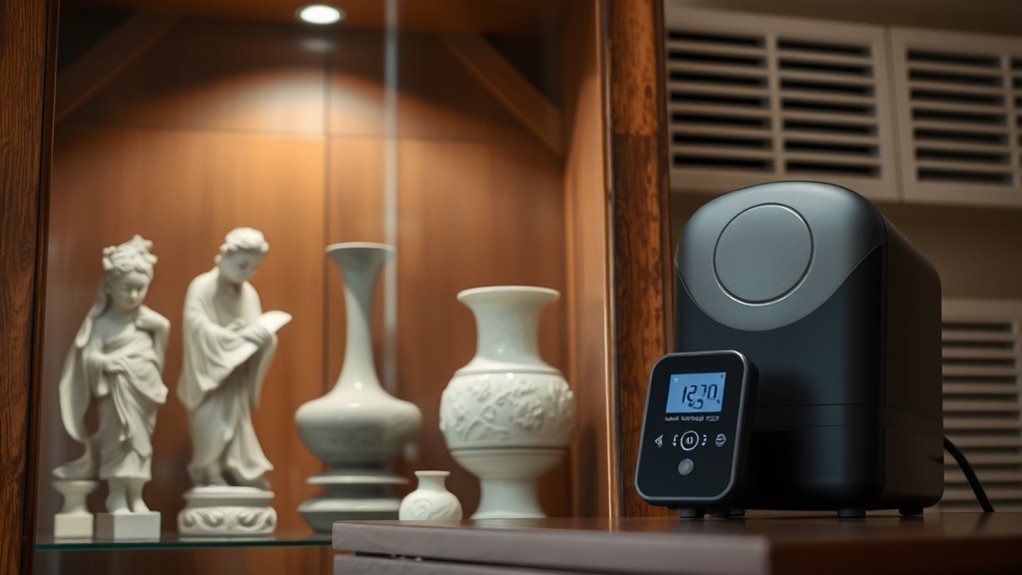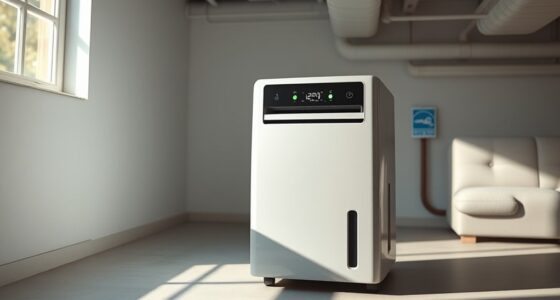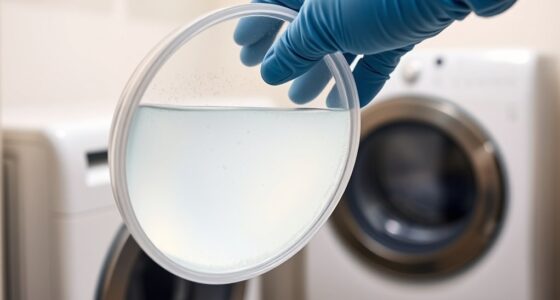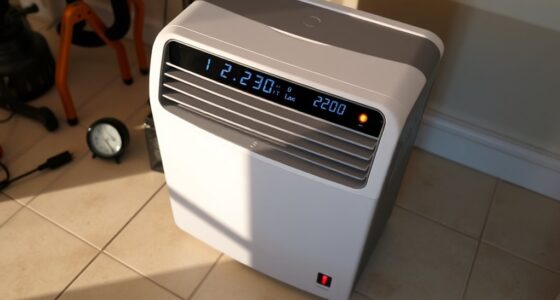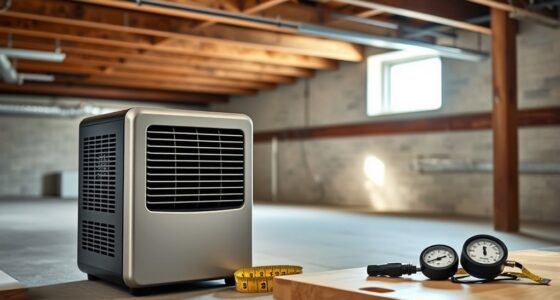To protect your art and antiques, maintaining proper humidity levels is essential. Keep the environment stable by controlling humidity between 45% and 55%, using climate control systems and monitoring devices. Proper insulation, sealing, and quick repairs prevent fluctuations. Store valuables in climate-controlled cases or facilities to avoid damage from dryness or excess moisture. By managing humidity effectively, you help preserve your collection’s beauty and integrity over time. Discover more ways to safeguard your collection as you continue.
Key Takeaways
- Maintain relative humidity between 45% and 55% to prevent material deterioration.
- Use climate control systems and continuous monitoring to ensure stable environmental conditions.
- Seal storage and display areas to minimize external climate fluctuations affecting artifacts.
- Address water leaks, ventilation issues, and seasonal changes promptly for consistent humidity levels.
- Store valuable items in climate-controlled environments or display cases with built-in humidity regulation.
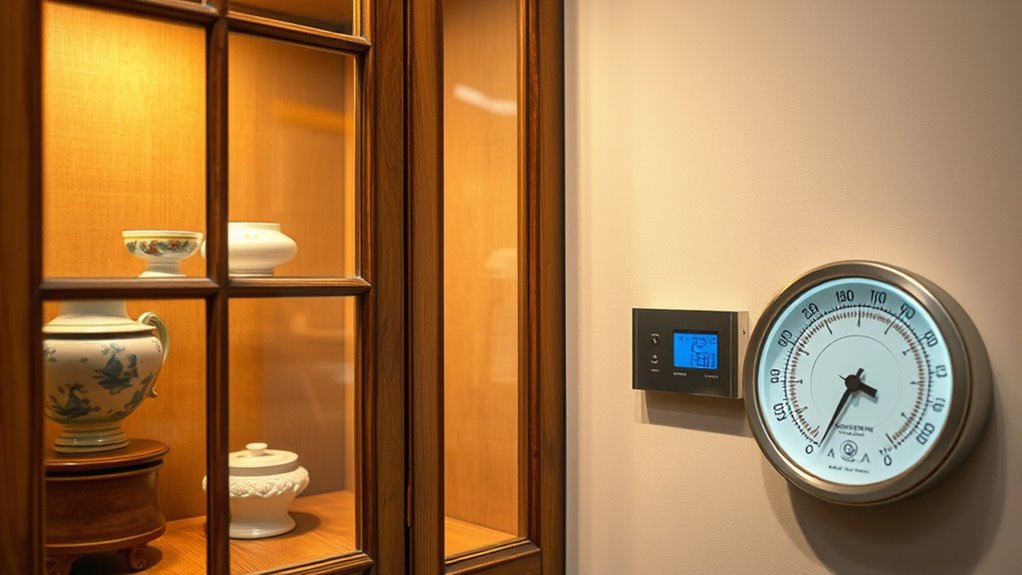
Protecting art and antiques is fundamental to preserving our cultural heritage and guaranteeing these treasures endure for future generations. One of the most effective ways to achieve this is by maintaining proper humidity levels. Fluctuations in climate can cause significant damage to delicate materials, making climate fluctuations a major threat to artifact preservation. When the air is too dry, materials like wood, paper, and textiles become brittle and prone to cracking. Conversely, excessive humidity can lead to mold growth, warping, and corrosion. By controlling humidity, you create a stable environment that minimizes these risks, safeguarding your collection for years to come.
Maintaining consistent humidity levels is essential because even minor fluctuations can accelerate deterioration. Sudden changes, such as those caused by seasonal shifts or air conditioning cycles, can stress artifacts and accelerate aging processes. To prevent this, you should use reliable climate control systems designed specifically for artifact preservation. These systems monitor and adjust the environment continuously, guaranteeing the relative humidity stays within an ideal range—typically between 45% and 55%. This range strikes a balance that prevents both dryness and excess moisture, protecting your artifacts from the damaging effects of climate fluctuations.
In addition, it’s important to understand that humidity control isn’t just about installing a dehumidifier or humidifier; it involves creating a thorough approach to artifact preservation. You should regularly monitor humidity levels using hygrometers, especially if your collection is stored in an environment exposed to outdoor conditions or fluctuating temperatures. Proper insulation and sealing of display cases or storage areas also help maintain stable conditions, reducing the impact of external climate variations. These steps ensure that your art and antiques remain in a consistent environment, which is essential for long-term preservation. Proper humidity management is an essential component of a comprehensive preservation strategy.
Furthermore, you need to be vigilant about potential sources of humidity changes, such as water leaks or inadequate ventilation. Addressing these issues promptly helps maintain the delicate balance necessary for artifact preservation. If you’re storing valuable or fragile items, consider investing in climate-controlled storage facilities or display cases with built-in humidity regulation. These solutions provide an extra layer of protection by shielding artifacts from unpredictable environmental changes. Ultimately, your goal should be to create a stable, controlled environment that minimizes the risks posed by climate fluctuations, guaranteeing your collection remains intact and vibrant for future generations to appreciate.
Frequently Asked Questions
How Do Humidity Levels Vary in Different Climate Zones?
You should understand that humidity levels vary considerably across different climate zones. In humid zones, like tropical areas, humidity variation is high, often leading to excess moisture. Conversely, arid zones experience low humidity and less variation. Knowing your climate zone helps you anticipate these fluctuations, so you can adjust humidity control measures accordingly. This guarantees your art and antiques stay in ideal condition, regardless of external climate changes.
Can Electronic Humidifiers Cause Damage to Delicate Artworks?
Electronic humidifiers can pose risks to artwork safety if not used correctly. If they over-humidify, excess moisture may cause mold, warping, or paint damage on delicate artworks. To prevent this, you should monitor humidity levels closely and maintain them within a safe range. Properly calibrated electronic humidifiers help control moisture, reducing damage risks and ensuring your artworks stay protected and preserved over time.
What Are the Signs of Improper Humidity Affecting Art?
Think of your artwork as a delicate dance, easily thrown off balance. Signs of improper humidity include cracks, warping, or paint flaking, which indicate art deterioration. You might also notice mold growth forming like dark spots or fuzzy patches. These issues signal that moisture levels are off, risking damage. Keep an eye out for these signs to protect your art from the destructive effects of improper humidity.
How Often Should Humidity Levels Be Monitored in Storage Areas?
You should monitor humidity levels in storage areas at least once a day to maintain climate stability. Use reliable humidity sensors to track fluctuations consistently. Regular monitoring helps you detect sudden changes that could harm your collection. By staying vigilant, you guarantee your environment remains ideal for your art and antiques, preventing damage caused by improper humidity levels. This routine keeps your items safe and preserves their value over time.
Are There Specific Materials More Sensitive to Humidity Fluctuations?
You should know that humidity-sensitive materials, like paper, textiles, and wood, are more vulnerable to fluctuations. These changes cause material deterioration over time, leading to warping, cracking, or mold growth. You need to monitor humidity levels regularly to prevent damage. By maintaining stable humidity, you help preserve the integrity of these delicate items, ensuring they stay in good condition for years to come.
Conclusion
By maintaining proper humidity levels, you safeguard your art and antiques from damage caused by fluctuations. Some might think occasional changes won’t harm, but even minor shifts can cause cracking or warping over time. Don’t wait until it’s too late—consistent humidity control preserves your treasures’ beauty and value for generations to come. Take action now, and make certain your collection remains protected, vibrant, and intact for years ahead.
